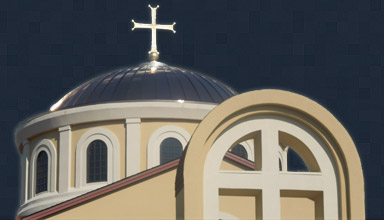|
Regular Services
Church School - after Holy Communion, follows traditional school year (Sept - June) Special Services
See Saint Barbara Parish Calendar for Events and Worship Services throughout the year. Meaning of the Word "Liturgy"
Metropolitan Kallistos Ware of Diokleia speaks about the meaning of the word "Liturgy" and the role of clergy and laity in the life of the Church. This video is an excerpt from a lecture series during his visit on February 15-20, 2011 to the Greek Orthodox Metropolis of Detroit.
Articles Related to Worship
|
The Divine Liturgy
The Divine Liturgy is the primary worship service of the Church. The most commonly celebrated forms of the Divine Liturgy are the Liturgy of St. John Chrysostom, the Liturgy of St. Basil, and the Liturgy of the Presanctified Gifts. The Divine Liturgy is a eucharistic service.
On most Sundays of the year when you arrive at Saint Barbara the Divine Liturgy of St. John Chrysostom will be the worship service. It is the primary worship service of over 300 million Orthodox Christians around the world, from Greece to Finland, from Russia to Tanzania, from Japan to Kenya, Bulgaria to Australia. It is celebrated in dozens of languages all around the world, from the original Greek it was written in to English, French, Slavonic, Swahili, Korean, Arabic and many others. Our services are in Greek and English. Greek as a reminder of the language of the New Testament and the early Church. We use English because, true to the actions of the Holy Apostles who employed “Koine” Greek, the “common” language, to spread the message of our Lord Jesus Christ to all, English is the common language of our modern American lives.
Books of the Divine Liturgy of St. John Chrysostom can be found in the rear pockets of most seats in St Barbara church. These will allow you to follow along with the Liturgic prayers and the hymns. They include the musical score for the hymns as well as the words in English, Greek and a transliteration of the Greek for readers of English. What does "Liturgy" mean?
Liturgy is a Greek word that in classical times referred to the performance of a public duty; in the Septuagint, the Greek translation of the Old Testament made some 300 years before the coming of Christ and still used by the Church today, it referred to worship in the Temple in Jerusalem; and for Orthodox Christians it has come to mean the public worship of the Church. Because Liturgy is always a corporate, communal action, it is often translated as ― "the work of the people" and because it is prefaced by the word ― "Divine", it is specifically the work of God‘s people and an experience of God‘s coming Kingdom here and now by those who gather to worship Him. This means that the Liturgy is not something that the clergy "performs" for the laity. The Liturgy was never meant to be a performance or a spectacle merely to be witnessed by onlookers. All who are present for worship must be willing, conscious and active participants and not merely passive spectators. The laity con-celebrate with the officiating clergy as baptized believers and members of the "royal priesthood...a people belonging to God" (1 Peter 2:9). |
||||||||
 |
|||||||
|
|
He shows that she is worthy to hear and not to be overlooked, and then He reveals Himself. For she, as soon as she had learnt who He was, would straightway hearken and attend to Him; ...
|
||||||
 |
|||||||
 |
St. Barbara Greek Orthodox Church 8306 NC Highway 751 Durham, North Carolina 27713-6860 919-484-1600 Email: fatherstavroforos2012@gmail.com webmaster@stbarbarachurchnc.org |







